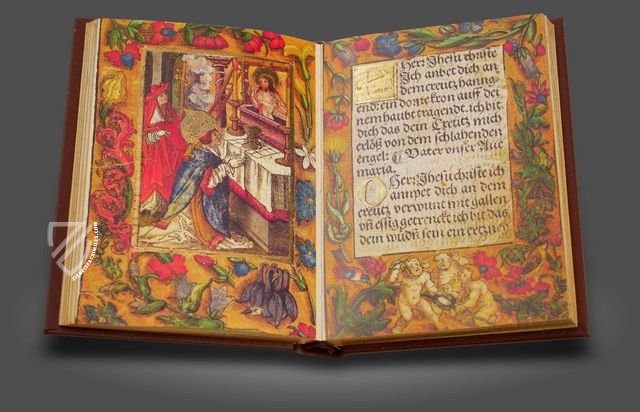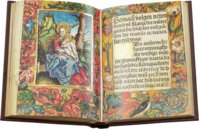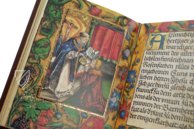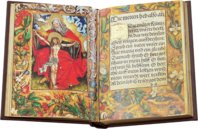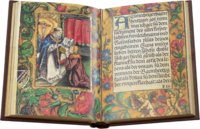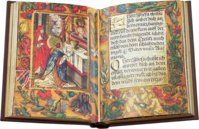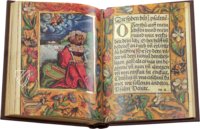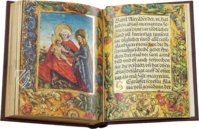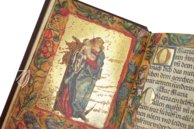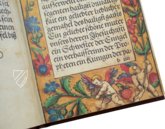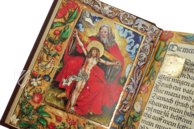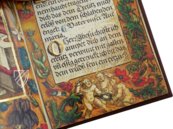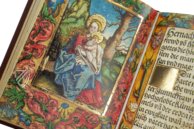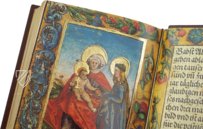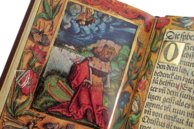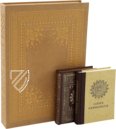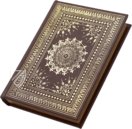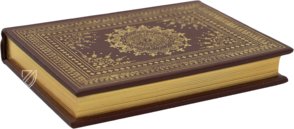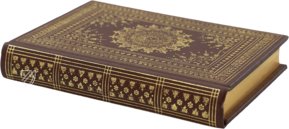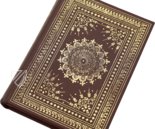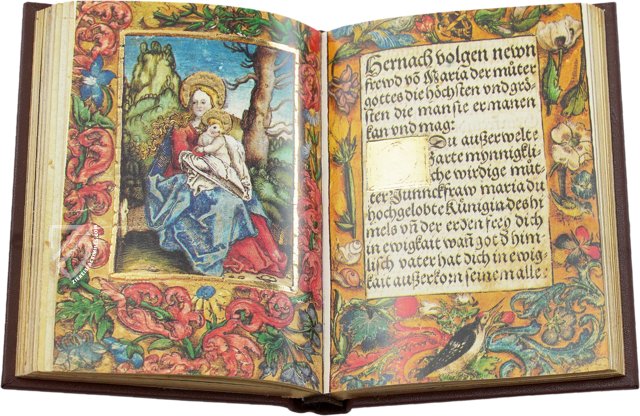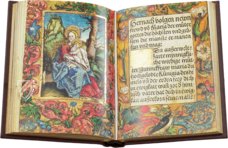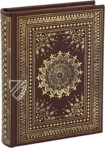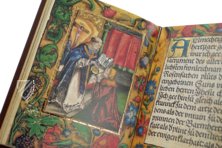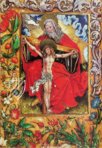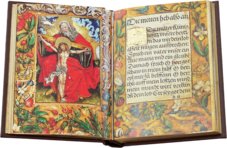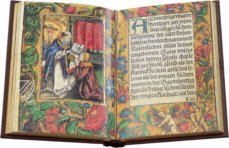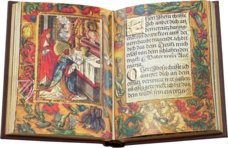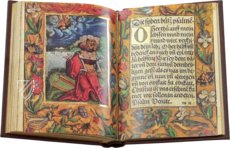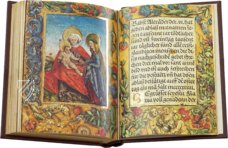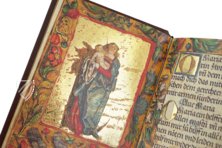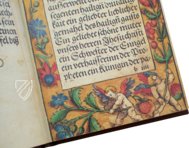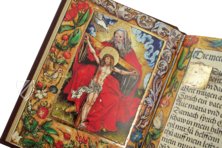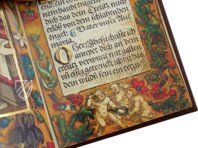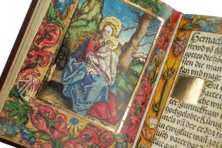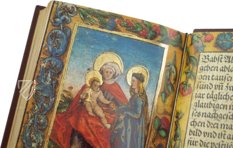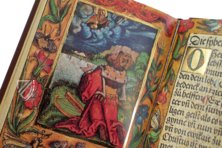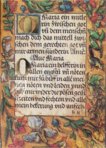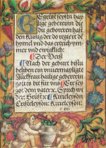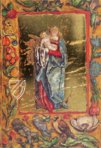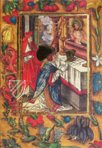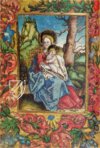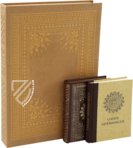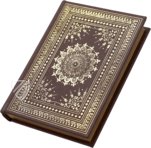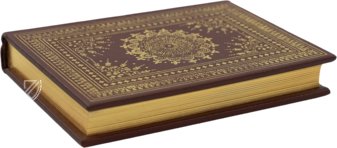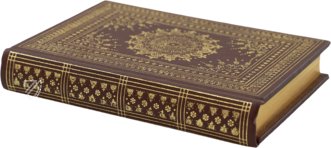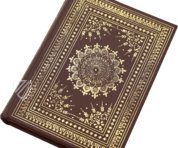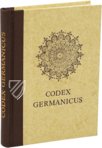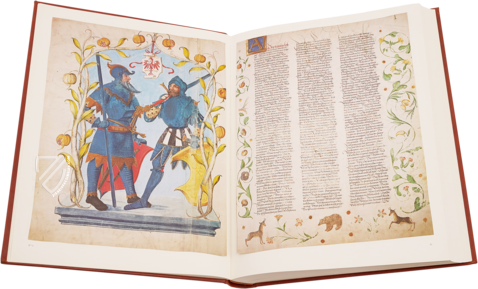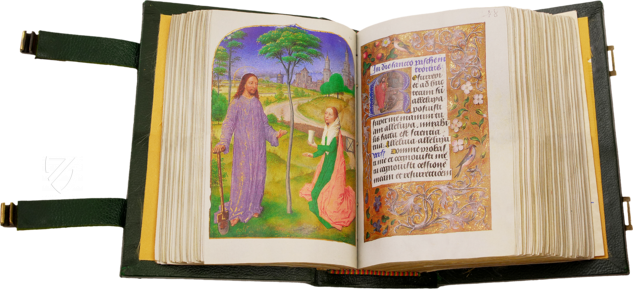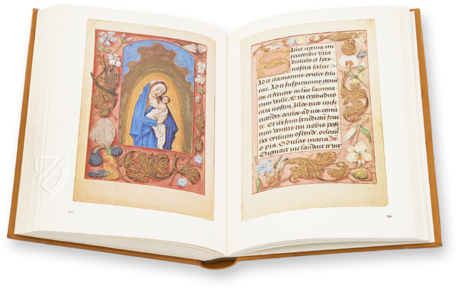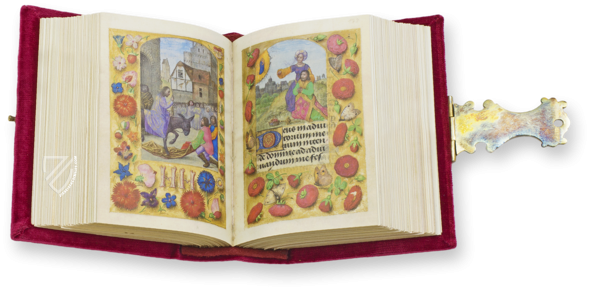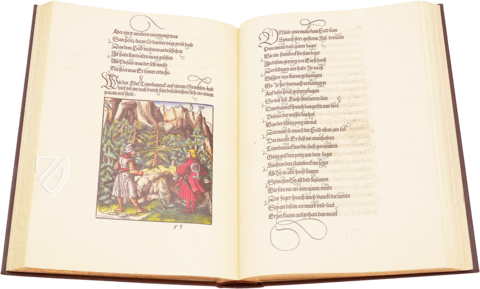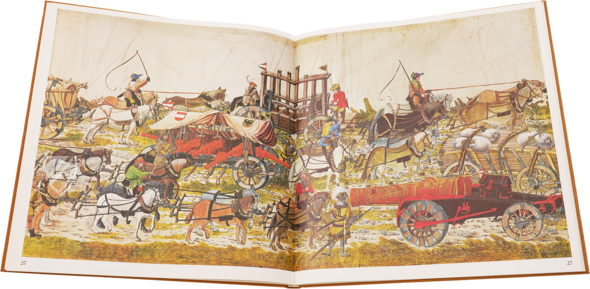Codex Germanicus
(under 1,000€)
The Codex Germanicus is one of the most important witnesses to European bookmaking in the late 15th and early 16th centuries, when new printing techniques were incorporated into the art of manuscript production, which was then in its last and arguably most magnificent period. It is a manuscript copy of a printed book that was supposedly commissioned by the Emperor Maximilian I, but the exact circumstances of its creation remain unclear. Seven full-page woodcuts by Hans Weiditz the Younger and numerous engraved frames adorn the German prayerbook, which originated from a masterful scribe. The ownership history of the book is also intertwined with the tumultuous history of Hungary between the 16th and 18th centuries.
Codex Germanicus
At the end of the 15th and beginning of the 16th centuries, European manuscript production was experiencing its last and most brilliant flowering at the same time that book printing was spreading across the continent. Nonetheless, the upper nobility continued to favor handmade codices using parchment over printed books with inexpensive paper. While there was obviously a rivalry between the two methods, there was also overlap and borrowing between them. One of the most beautiful examples of this is a manuscript stored today in the Budapest University Library under the shelf mark Codex Germanicus 3.
An Imperial Commission?
The Codex Germanicus is an early 16th century German manuscript that is a transcription of a contemporary printed prayerbook known under the short title Gilgengart, of which two editions were published on rough parchment in Augsburg by Johann Schönsperger the Elder (1455–1521) in 1520 and 1521. He had been appointed court printer to Emperor Maximilian I (1459–1519) in 1508 and although there is no direct link to the Emperor, there are numerous indicators both in the script used and the circumstances of the print that it was originally an imperial commission, but was not finished during Maximilian’s lifetime. This would by no means be the only printed book commissioned by Maximilian whose final publication was delayed by financial restrictions, even if the letters and woodcuts were already finished.
The Hungarian Connection
Maximilian had previously commissioned the copying of printed books by hand, and the fact that the text of the manuscript was adopted for a female audience indicates that it may have originated as a wedding gift for his granddaughter Mary of Austria (1505–58), who married King Louis II of Hungary (1506 –26) in 1515. After the death of her husband in the Battle of Mohács in 1526, Mary fled to Preßburg, modern Bratislava, Slovakia where she stayed for several months and deposited some of her treasures and books in the local church library. After the library was dissolved by Emperor Joseph II (1741–90), the manuscript was acquired in 1782 by Michael Winkler, who was a priest in Bonyhád, Hungary. This explains how the manuscript first came to Hungary in the early 16th century and returned there in the late 18th century.
The Unique Contents
The masterfully written Fraktur text adorned by golden initials appears to be based on the 1520 print but is not an exact copy despite being written in the same dialect: there are small deviations in formatting, spelling, and male forms are replaced by female ones (e.g. “ich arme Sünderin” instead of “ich armer Sünder”). In contrast to the texts of other German prayerbooks that developed since the 14th century, the Gilgengart text differs in both form and content. It contains 47 independent texts assembled from various sources, 19 of which are devoted to the Virgin Mary, but lacks a calendar and some other typical elements. Overall, the texts share four themes in common: penance, the acquisition and accumulation of indulgences, and devotion to the suffering Christ and Mary.
A Synthesis of the Arts
There are no indicators of the circumstances under which the manuscript originated because both the title page and original binding are missing, but it was created with 111 folios of fine parchment cut to 133 x 100 mm. The seven woodcuts decorating the manuscript originate from Hans Weiditz the Younger (1485 – ca. 1537), also known as The Petrarch Master, during his early period. They are characterized by their preference for a diagonal spatial perception, central compositional scheme, the proportions of dark and light areas, and the motifs of the ornamental frames. Weidtz was influenced by his master Hans Burgkmair (1473–1531) as well as other contemporaries like Albrecht Dürer (1471–1528), Hans Schäufelein (ca. 1480–1540), and Leonhard Beck (ca. 1480 – 1542). 23 pages are also adorned with elaborate woodcut frames with typical vegetal and zoomorphic themes that were likely colored in by the same hand that was responsible for the initials. The current leather binding from the turn of the 18th century was created in Tyrnau, Austria.
Codicology
- Alternative Titles
- Codex Germanicus 3
- Size / Format
- 222 pages / 13.3 × 10.0 cm
- Origin
- Germany
- Date
- Beginning of the 16th century
- Epochs
- Style
- Genre
- Language
- Illustrations
- 7 colored full-page woodcuts; 23 woodcut bordures; Several golden initials
- Content
- Gilgengart
- Artist / School
- Hans Weiditz the Younger (1485 – ca. 1537)
- Previous Owners
- Michaelis Winckler
Codex Germanicus
Mass of St. Gregory
This popular scene in medieval Christian art depicts the vision of Christ with the wounds of the Passion, the so-called Man of Sorrows, which appeared before Pope Gregory I while performing mass. The miracle was supposed to have proved to a doubting woman who baked the communion bread that transubstantiation was in fact real. It reproduces the diagonal perspective of a woodcut by Albrecht Dürer on the same subject but in reverse with the Pope on the left and the altar on the right.
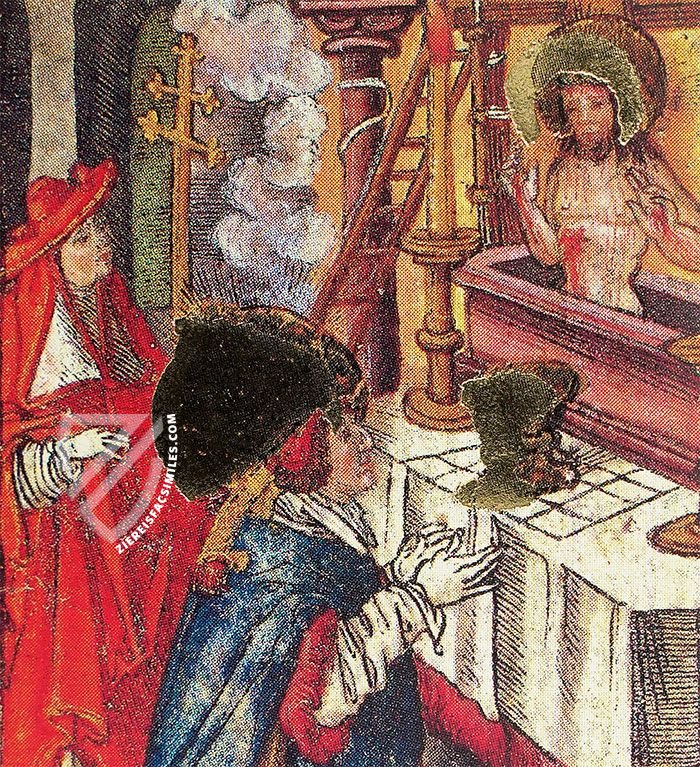
Codex Germanicus
The Holy Trinity
This woodcut is a variant of the sedes gratia or “Throne of Mercy”, a pictorial type in Christian art for representing the Trinity that first appeared in the late 10th century. It typically consists of an enthroned God the Father holding a crucified Christ in his hands as a dove symbolizing the Holy Spirit appears either above or between them.
Most depictions of the Throne of Mercy have a direct frontal perspective that confronts the beholder but Weidtz’s preference for the diagonal perspective makes it seem as though one were passing by this miraculous vision as it appeared on the side of the road. Like in the rest of the manuscript, the frame with vegetal and zoomorphic motifs is purely decorative and has no allusions to the primary scene.
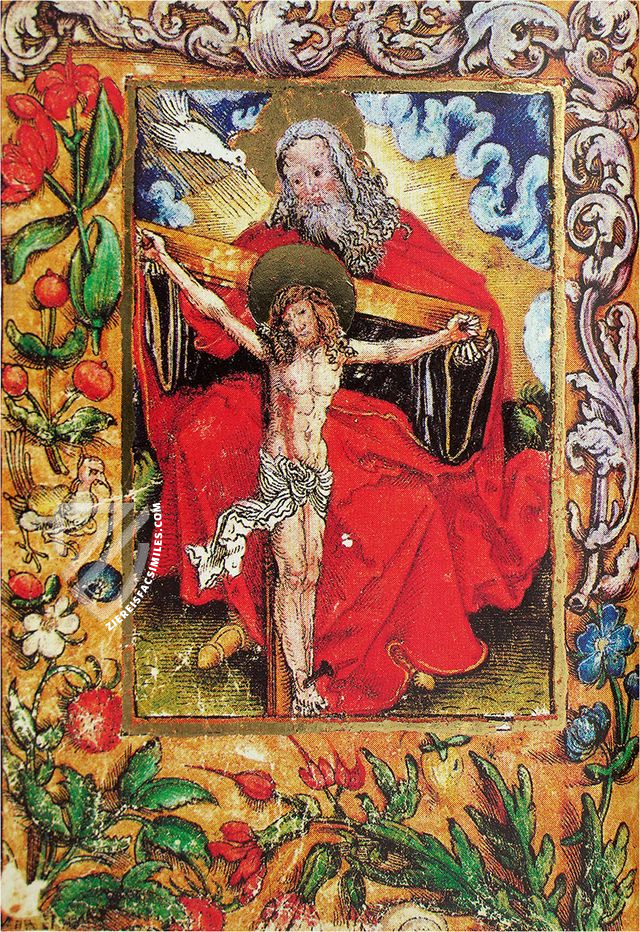
#1 Codex Germanicus
Languages: German, Hungarian
(under 1,000€)
- Treatises / Secular Books
- Apocalypses / Beatus
- Astronomy / Astrology
- Bestiaries
- Bibles / Gospels
- Chronicles / History / Law
- Geography / Maps
- Saints' Lives
- Islam / Oriental
- Judaism / Hebrew
- Single Leaf Collections
- Leonardo da Vinci
- Literature / Poetry
- Liturgical Manuscripts
- Medicine / Botany / Alchemy
- Music
- Mythology / Prophecies
- Psalters
- Other Religious Books
- Games / Hunting
- Private Devotion Books
- Other Genres
- Afghanistan
- Armenia
- Austria
- Belgium
- Belize
- Bosnia and Herzegovina
- China
- Colombia
- Costa Rica
- Croatia
- Cyprus
- Czech Republic
- Denmark
- Egypt
- El Salvador
- Ethiopia
- France
- Germany
- Greece
- Guatemala
- Honduras
- Hungary
- India
- Iran
- Iraq
- Israel
- Italy
- Japan
- Jordan
- Kazakhstan
- Kyrgyzstan
- Lebanon
- Liechtenstein
- Luxembourg
- Mexico
- Morocco
- Netherlands
- Palestine
- Panama
- Peru
- Poland
- Portugal
- Romania
- Russia
- Serbia
- Spain
- Sri Lanka
- Sweden
- Switzerland
- Syria
- Tajikistan
- Turkey
- Turkmenistan
- Ukraine
- United Kingdom
- United States
- Uzbekistan
- Vatican City
- A. Oosthoek, van Holkema & Warendorf
- Aboca Museum
- Ajuntament de Valencia
- Akademie Verlag
- Akademische Druck- u. Verlagsanstalt (ADEVA)
- Aldo Ausilio Editore - Bottega d’Erasmo
- Alecto Historical Editions
- Alkuin Verlag
- Almqvist & Wiksell
- Amilcare Pizzi
- Andreas & Andreas Verlagsbuchhandlung
- Archa 90
- Archiv Verlag
- Archivi Edizioni
- Arnold Verlag
- ARS
- Ars Magna
- ArtCodex
- AyN Ediciones
- Azimuth Editions
- Badenia Verlag
- Bärenreiter-Verlag
- Belser Verlag
- Belser Verlag / WK Wertkontor
- Benziger Verlag
- Bernardinum Wydawnictwo
- BiblioGemma
- Biblioteca Apostolica Vaticana (Vaticanstadt, Vaticanstadt)
- Bibliotheca Palatina Faksimile Verlag
- Bibliotheca Rara
- Boydell & Brewer
- Bramante Edizioni
- Bredius Genootschap
- Brepols Publishers
- British Library
- C. Weckesser
- Caixa Catalunya
- Canesi
- CAPSA, Ars Scriptoria
- Caratzas Brothers, Publishers
- Carus Verlag
- Casamassima Libri
- Centrum Cartographie Verlag GmbH
- Chavane Verlag
- Christian Brandstätter Verlag
- Circulo Cientifico
- Club Bibliófilo Versol
- Club du Livre
- CM Editores
- Collegium Graphicum
- Collezione Apocrifa Da Vinci
- Comissão Nacional para as Comemorações dos Descobrimentos Portugueses
- Coron Verlag
- Corvina
- CTHS
- D. S. Brewer
- Damon
- De Agostini/UTET
- De Nederlandsche Boekhandel
- De Schutter
- Deuschle & Stemmle
- Deutscher Verlag für Kunstwissenschaft
- DIAMM
- Droz
- E. Schreiber Graphische Kunstanstalten
- Ediciones Boreal
- Ediciones Grial
- Ediclube
- Edições Inapa
- Edilan
- Editalia
- Edition Deuschle
- Edition Georg Popp
- Edition Leipzig
- Edition Libri Illustri
- Editiones Reales Sitios S. L.
- Éditions de l'Oiseau Lyre
- Editions Medicina Rara
- Editorial Casariego
- Editorial Mintzoa
- Editrice Antenore
- Editrice Velar
- Edizioni Edison
- Egeria, S.L.
- Eikon Editores
- Electa
- Emery Walker Limited
- Enciclopèdia Catalana
- Eos-Verlag
- Ephesus Publishing
- Ernst Battenberg
- Eugrammia Press
- Extraordinary Editions
- Fackelverlag
- Facsimila Art & Edition
- Facsimile Editions Ltd.
- Facsimilia Art & Edition Ebert KG
- Faksimile Verlag
- Feuermann Verlag
- Folger Shakespeare Library
- Franco Cosimo Panini Editore
- Friedrich Wittig Verlag
- Fundación Hullera Vasco-Leonesa
- G. Braziller
- Gabriele Mazzotta Editore
- Gebr. Mann Verlag
- Gesellschaft für graphische Industrie
- Getty Research Institute
- Giovanni Domenico de Rossi
- Giunti Editore
- Graffiti
- Grafica European Center of Fine Arts
- Guido Pressler
- Guillermo Blazquez
- Gustav Kiepenheuer
- H. N. Abrams
- Harrassowitz
- Harvard University Press
- Helikon
- Hendrickson Publishers
- Henning Oppermann
- Herder Verlag
- Hes & De Graaf Publishers
- Hoepli
- Holbein-Verlag
- Houghton Library
- Hugo Schmidt Verlag
- Idion Verlag
- Il Bulino, edizioni d'arte
- ILte
- Imago
- Insel Verlag
- Insel-Verlag Anton Kippenberger
- Instituto de Estudios Altoaragoneses
- Instituto Nacional de Antropología e Historia
- Introligatornia Budnik Jerzy
- Istituto dell'Enciclopedia Italiana - Treccani
- Istituto Ellenico di Studi Bizantini e Postbizantini
- Istituto Geografico De Agostini
- Istituto Poligrafico e Zecca dello Stato
- Italarte Art Establishments
- Jan Thorbecke Verlag
- Johnson Reprint Corporation
- Josef Stocker
- Josef Stocker-Schmid
- Jugoslavija
- Karl W. Hiersemann
- Kasper Straube
- Kaydeda Ediciones
- Kindler Verlag / Coron Verlag
- Kodansha International Ltd.
- Konrad Kölbl Verlag
- Kurt Wolff Verlag
- La Liberia dello Stato
- La Linea Editrice
- La Meta Editore
- Lambert Schneider
- Landeskreditbank Baden-Württemberg
- Leo S. Olschki
- Les Incunables
- Liber Artis
- Library of Congress
- Libreria Musicale Italiana
- Lichtdruck
- Lito Immagine Editore
- Lumen Artis
- Lund Humphries
- M. Moleiro Editor
- Maison des Sciences de l'homme et de la société de Poitiers
- Manuscriptum
- Martinus Nijhoff
- Maruzen-Yushodo Co. Ltd.
- MASA
- Massada Publishers
- McGraw-Hill
- Metropolitan Museum of Art
- Militos
- Millennium Liber
- Müller & Schindler
- Nahar - Stavit
- Nahar and Steimatzky
- National Library of Wales
- Neri Pozza
- Nova Charta
- Oceanum Verlag
- Odeon
- Orbis Mediaevalis
- Orbis Pictus
- Österreichische Staatsdruckerei
- Oxford University Press
- Pageant Books
- Parzellers Buchverlag
- Patrimonio Ediciones
- Pattloch Verlag
- PIAF
- Pieper Verlag
- Plon-Nourrit et cie
- Poligrafiche Bolis
- Presses Universitaires de Strasbourg
- Prestel Verlag
- Princeton University Press
- Prisma Verlag
- Priuli & Verlucca, editori
- Pro Sport Verlag
- Propyläen Verlag
- Pytheas Books
- Quaternio Verlag Luzern
- Reales Sitios
- Recht-Verlag
- Reichert Verlag
- Reichsdruckerei
- Reprint Verlag
- Riehn & Reusch
- Roberto Vattori Editore
- Rosenkilde and Bagger
- Roxburghe Club
- Salerno Editrice
- Saltellus Press
- Sandoz
- Sarajevo Svjetlost
- Schöck ArtPrint Kft.
- Schulsinger Brothers
- Scolar Press
- Scrinium
- Scripta Maneant
- Scriptorium
- Shazar
- Siloé, arte y bibliofilia
- SISMEL - Edizioni del Galluzzo
- Sociedad Mexicana de Antropología
- Société des Bibliophiles & Iconophiles de Belgique
- Soncin Publishing
- Sorli Ediciones
- Stainer and Bell
- Studer
- Styria Verlag
- Sumptibus Pragopress
- Szegedi Tudomànyegyetem
- Taberna Libraria
- Tarshish Books
- Taschen
- Tempus Libri
- Testimonio Compañía Editorial
- Thames and Hudson
- The Clear Vue Publishing Partnership Limited
- The Facsimile Codex
- The Folio Society
- The Marquess of Normanby
- The Richard III and Yorkist History Trust
- Tip.Le.Co
- TouchArt
- TREC Publishing House
- TRI Publishing Co.
- Trident Editore
- Tuliba Collection
- Typis Regiae Officinae Polygraphicae
- Union Verlag Berlin
- Universidad de Granada
- University of California Press
- University of Chicago Press
- Urs Graf
- Vallecchi
- Van Wijnen
- VCH, Acta Humaniora
- VDI Verlag
- VEB Deutscher Verlag für Musik
- Verlag Anton Pustet / Andreas Verlag
- Verlag Bibliophile Drucke Josef Stocker
- Verlag der Münchner Drucke
- Verlag für Regionalgeschichte
- Verlag Styria
- Vicent Garcia Editores
- W. Turnowski Ltd.
- W. Turnowsky
- Waanders Printers
- Wiener Mechitharisten-Congregation (Wien, Österreich)
- Wissenschaftliche Buchgesellschaft
- Wissenschaftliche Verlagsgesellschaft
- Wydawnictwo Dolnoslaskie
- Xuntanza Editorial
- Zakład Narodowy
- Zollikofer AG

